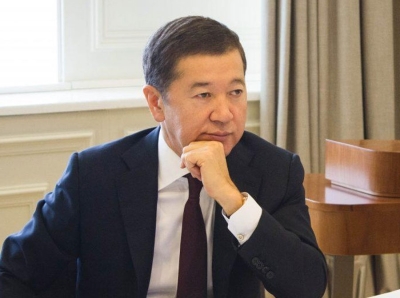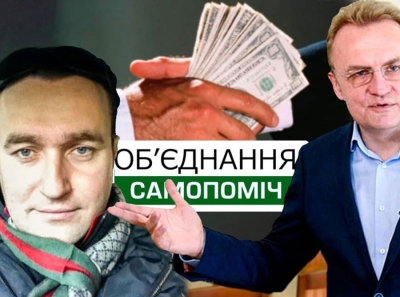Victor Pinchuk is profiteering from at least 58 Interpipe Group companies in Russia
Since 2014, Victor Pinchuk has only increased cooperation with Russians, and the Interpipe’s company facilities reliably pay taxes there. Nevertheless, Viktor Mykhailovych Pinchuk travels to the USA and EU countries, trying to present Interpipe as purely Ukrainian. Pinchuk’s ties with the Kremlin are extensive and long-standing.
Many Ukrainian politicians, oligarchs, and business structures “changed their minds” after February 2022: they shifted their rhetoric from “negotiations are necessary” to “defeat the aggressor on the battlefield.” One example of someone who earned billions with Russia but is now doing everything to be forgotten is Victor Pinchuk, the owner of Interpipe group of companies.
In 2005, an intergovernmental agreement was concluded between the Ministry of Economic Development of the Russian Federation and the Ministry of Economy of Ukraine, regulating the supply of certain types of steel pipes from Ukraine to the customs territory of the Russian Federation. According to this agreement, Interpipe’s products were exempted from additional import duties.
The list of approved plants included LLC “INTERPIPE NIKO TYUB,” OJSC “INTERPIPE NOVOMOSKOVSK PIPE PLANT,” and OJSC “INTERPIPE NIZHNEDNEPROVSKY PIPE ROLLING PLANT.” In other words, the supply of pipes produced by Interpipe to Russians was protected by a direct international agreement between Ukraine and Russia.
Information about the movement of goods across borders is largely open. Numerous databases allow one to see who, how much, and where products were supplied. Between Ukraine and Russia, such a database is maintained based on customs service data. A search for “Interpipe” reveals how Interpipe traded with Russia during the war from 2014, strengthening its economy through product deliveries and paying hundreds of millions of dollars into the Russian budget.
In 2016, an article by the owner of Interpipe titled “Ukraine Must Make Painful Compromises for Peace With Russia” was published in The Wall Street Journal. The article suggests that Ukraine should concede occupied territories for the sake of peace with Russia.
 PIN IT
PIN IT
Information about the crossing of goods across borders is largely transparent. Numerous databases allow one to observe who, how much, and where products were delivered. Between Ukraine and Russia, such a database is maintained based on customs service data. A search for “Interpipe” reveals how Interpipe traded with Russia during the war from 2014, boosting its economy through product deliveries and contributing hundreds of millions of dollars to the Russian budget.
In 2016, an article by the owner of Interpipe titled “Ukraine Must Make Painful Compromises for Peace With Russia” was published in The Wall Street Journal. The article suggests that Ukraine should concede occupied territories for the sake of peace with Russia.
Interestingly, on the day this article was published, according to customs databases, 12 trucks loaded with Interpipe pipes (225 tons) crossed the Ukrainian-Russian border for LLC “Lesstroytorg.” This day was not exceptional; similar occurrences happened almost daily. For instance, on another day, Interpipe sent 50 trucks carrying 970 tons to Russia. The cargo recipient was a Russian division of Interpipe – LLC “Interpipe-M,” which is still not liquidated in Russia.
Victor Pinchuk: the true intentions
This fact vividly illustrates the objectives the beneficiary of Interpipe wanted to achieve with the article. Most likely, the desire to maintain business in Russia stood behind the talk of compromises with Russia.
It is worth noting the declared customs value of the goods that Interpipe transported from Ukraine to Russia. According to declaration No. 110120001/413677, the transported items were “seamless cold-drawn steel tubes of particularly high precision.” The total invoice value for 20.5 tons was declared as 657 USD. This translates to 32 USD per ton. Such a price is not present in the market. The market price for one ton of steel is around 700 USD. In other words, instead of Ukrainian companies making a profit and paying taxes to the state budget, the declared customs value of the goods was understated by 95%.
The situation with wheel sets for railways is equally interesting. Taking one of the shipments as an example, when 7 trucks crossed the Ukrainian-Russian border with a load of 130 tons of wheel sets (customs declaration No. 110120001/413742), the declared value was (attention) 2599.47 USD. This is 371 USD for a 20-ton truck of wheelsets. The market price for one wheel set weighing 1.15 tons is approximately 2000 USD. The market price for a truck of wheel sets is around 35,000 USD. Interpipe, however, declares 371 USD. This is a depreciation of the value by almost a hundred times. In other words, this is money that Interpipe did not receive in Ukraine, and later, through its Russian company Interpipe-M, registered in the elite Moscow City, sold this product at market value in Russia. And the money stayed in Russia.
The business scheme of Interpipe in supplying goods to Russia is highlighted by this delivery: 1/10 of the cost remains in Ukraine, while 9/10 stays in Russia.
Particularly cynical and symbolic is the fact that on the day when trucks with Interpipe goods for Russia crossed the Ukrainian-Russian border (September 30, 2016), Russian Foreign Minister Sergey Lavrov refused to apologize for the destruction of the “Boeing.”
After the article in The Wall Street Journal about the need for compromises with Putin, Interpipe’s rights in Russia soared. The revenue of the Russian division of Interpipe began to grow, increasing from 4.9 billion rubles in 2015 to 6.9 billion rubles in 2016, reaching a peak of 10 billion rubles in 2017. This is not surprising, considering the simple scheme: Ukrainian Interpipe plants sell their products to their Russian company at a low cost, and it then handles sales in the Russian market, generating revenue.
And so it went on for all the years of the Russo-Ukrainian war. All this data is available in tables and is publicly accessible. They have hundreds of Russian partners.
Notably, according to the “Schemes” investigation in 2019, Pinchuk exported pipes and wheelsets to Russia for 1 billion hryvnias. Just imagine the actual market value of these goods and how much Ukraine and the Ukrainian budget missed out on.
And now, the main point. As evident from the data of Ukrainian and Russian customs, Interpipe sold its products to Russia in two ways: directly to Russian companies at market prices or at reduced prices to its Russian subsidiary, Interpipe-M, which then carried out further sales to Russian clients.
Only from 2016 to 2019, Interpipe supplied wheels to Russia with a declared customs value of 119.5 million USD and pipes worth 75.3 million USD. As we saw, in some cases, the declared customs value was 95% lower than the market value.
From open data on Rusprofile, we see that the revenue in the Russian market for Interpipe-M alone (excluding the revenue of Ukrainian units of Interpipe, which directly sent goods across the customs border to other Russian enterprises) during the war years was:
- 2015: 80 million USD (4.9 billion rubles)
- 2016: 103 million USD (6.9 billion rubles)
- 2017: 172 million USD (10 billion rubles)
- 2018: 147 million USD (9.2 billion rubles)
In just four years, this amounts to half a billion USD.
Then the revenue began to decline, totaling “only” 887 million rubles over the next four years. However, it is worth noting that even after the start of the large-scale war, Interpipe continued to sell goods to Russia, pay taxes to the Russian budget, and maintain its office in Russia, despite statements about discontinuing such activities. In 2022, LLC “Interpipe-M” provided financial statements. In 2022, after Russia’s invasion of Ukraine, the revenue of the company “Interpipe-M” from the sale of goods in the Russian Federation amounted to 131.66 million rubles. In 2022, Interpipe received almost 72 million rubles in net profit from Russia. By the end of 2022, Interpipe paid almost 36 million rubles in corporate income tax to the Russian Federation budget.
Media outlets even published excerpts of funds movement on Interpipe’s accounts in Russia, clearly showing the maintenance of an office and employees in Moscow.
Is the reduction in Interpipe’s revenue in Russia a sign of ceasing operations in the aggressor country? No. The fact is that on November 7, 2022, “Interpipe-M” filed a lawsuit against another company in the Pinchuk group – Interpipe M.E FZE (UAE), which once got involved in supplying sanctioned goods to Iran. In essence, the “left hand” (in Russia) is suing the “right hand” (in the UAE) and is attempting to recover 2,957,434,042 (almost 3 billion) rubles. At the time of filing the lawsuit, this amounted to about 50 million USD. “Interpipe” paid a court fee of 200,000 rubles to the Russian budget for filing a lawsuit by one of its companies against another.
The case is being considered in court, with the next hearing scheduled for February 22, 2024.
Thus, formally reducing revenue in Russia, Interpipe still attempts to bring funds there in the amount of 50 million USD. Why does Interpipe need money in Russia?
All this happens against the backdrop of Interpipe’s statements that the West should strengthen support for Ukraine in resisting Russian armed aggression. It is just unclear why Interpipe is so eager to bring 50 million USD specifically to Russia and not to Ukraine?
It is worth mentioning that previously, Interpipe felt so comfortable in Russia that intergovernmental agreements were literally issued for its plants to lift additional duties. And here is the question. Did it feel comfortable only before?
Interestingly, could any Ukrainian manufacturer receive guarantees for supplying their products to Russia at the level of the intergovernmental agreement of 2005? At that time, the Minister of Economic Development of Russia was Herman Gref. Today, Gref heads Sberbank of Russia and is part of the group responsible for uninterrupted trade relations between Russia and other countries, ensuring the establishment of schemes and financial trails to mitigate the negative consequences of sanctions.
In 2016, the beneficiary of Interpipe in The Wall Street Journal spoke about the need for territorial concessions to Russia. In 2023, in Politico, there is talk of the need to defend the territorial integrity of Ukraine. Interpipe’s rhetoric is changing. One thing remains unchanged: Interpipe still has business in Russia (Interpipe-M) and continues to try to bring millions of dollars there.
From customs databases, it can be established that Ukrainian Interpipe enterprises shipped their products to no fewer than 58 Russian companies during the war. These are only the companies to which cargo was sent directly from Ukraine to Russia. It’s important not to forget that this is only part of the trade turnover. The other part went to the Russian subsidiary Interpipe-M, which then resold pipes, wheelsets, and other goods on the Russian market. All these companies to which Interpipe enterprises sold products pay taxes to the Russian budget, financing and continuing to finance the war against Ukraine.
The list of Victor Pinchuk’s Interpipe partners in Russia during the Russo-Ukrainian war:
1. AO “AGROSNAB”
2. AO “ORZ”
3. AO “ZMK”
4. AO “Roslavlskiy ORZ”
5. Wagon Repair Depot Bataysk – a separate structural unit of AO “Wagon Repair Company – 1”
6. Wagon Repair Depot “Bryansk-Lgovskiy” – a separate structural unit of AO “Wagon Repair Company – 1”
7. Wagon Repair Depot “Gorkiy-Sortirovochnyy” – a separate structural unit of AO “Wagon Repair Company – 1”
8. OAO “Kolomenskiy Zavod”
9. OAO “Magnitogorskiy Metallurgicheskiy Kombinat”
10. OAO “Oskolsnab”
11. VKM Kuloy
12. VChDr Volkhovstroy
13. VChDr Goroblagodatskaya AO “VRK-3”
14. ZAO Zheleznogorskiy Vagonoremontnyy Zavod RF 307170 G Zheleznogorsk Kurskaya Obl Promploshchadka 2
15. ZAO TSPTK “ChMS”
16. ZAO TSPTK “ChSM”
17. ZAO “Lesstroitorg”
18. “Muromskiy Zavod TransPuthMash” LLC
19. OAO “BENZ”
20. OAO “Lyudinovskiy Teplovozostroitelnyy Zavod”
21. OOO “ALNAS”
22. OOO “BSK”
23. OOO “VKM” Kotel
24. OOO VKM SERVIS 431444 RF RM RUZAEVSKIY RAYON G RUZAEVKA UL L TOLSTOGO D 7
25. OOO VLVRZ RF 182113 Pskovskaya Obl G Velikie Luki Pr Kt Oktyabrskiy D 117
26. OOO “VRP” “Novotrans”
27. OOO “Yeletskaya Vneshnetorgovaya Kompaniya”
28. OOO “Kashirskiy Vagonoremontnyy Zavod” “Novotrans”
29. OOO “LEMAZ”
30. OOO “LOGISTIKA 61”
31. OOO “Lysvanneftemash”
32. OOO PK “Promtub”
33. OOO PROMRESURS 346400 G Novocherkassk Ul Tramvaynaya Dom 57A
34. OOO TEKHTRANS RF 618909 Permskiy Kray G Lysva Ul Repina 2
35. OOO UK DIREKT KKhOLL 454036 RF G Chelyabinsk Ul Matrosova (Maisskiy) D 1 B Pomes 3
36. OOO UNITEK 614047 Permskiy Kray G Perm Ul Solikamskaya 317 Ofis 1
37. OOO “INTERPIPE-M”
38. PAO ‘Magnitogorskiy Metallurgicheskiy Kombinat’
39. RVD Liski
40. OOO “ALARIV GRUPP”
41. OOO “BAZIS logistik”
42. OOO “VAGONNO-KOLESNAYA MASTERSKAYA”
43. OOO “Industrialnyy park NPP”
44. OOO “SK Toros”
45. OOO “Uralgazservis”
46. “Center zakupok (CZ) PAO KAMAZ”
47. AO “ARKHANGEL’SKIY TRALOVOY FLOT”
48. AO “GAMMA GYUCH SISTEMLERY MYUHENDISLIK VE OOO KHYUT ANONIM SHIRKETY”
49. ZAO “International Paper”
50. ZAO STROYRESURS
51. Caspian Energy Projects LLC
52. OOO “BENTELER DISTRIBUTION RUSSIA”
53. OOO “Vyra”
54. OOO “MIRATORG ZAPAD”
55. OOO “SHTAUFF”
56. PAO “VYBORGSKIY SUDOSTROITEL’NY ZAVOD”
57. PAO “SEVERSTAL’”
58. Representation of the company “Schlumberger Logelco Inc.”









